Technical Reasons to Buy Gold
Commodities / Gold & Silver Aug 21, 2008 - 11:18 AM GMTBy: Peter_Zihlmann
 1980 to 2008: From bear to bull: the multi-year trends and the long-term picture.
1980 to 2008: From bear to bull: the multi-year trends and the long-term picture.
The chart below clearly shows one thing: long-term trends often last many years . The bear market that started in 1988 ended in 1993. The up-swing that followed lasted three years from 1993 until 1996 and culminated in what may be called a false break-out. Then another bear-market unfolded taking the gold price down to $ 250 over a period of almost four years.
Then the spike in the gold price (1999) came as a consequence of the central banks' announcement that they would be limiting their gold-sales.
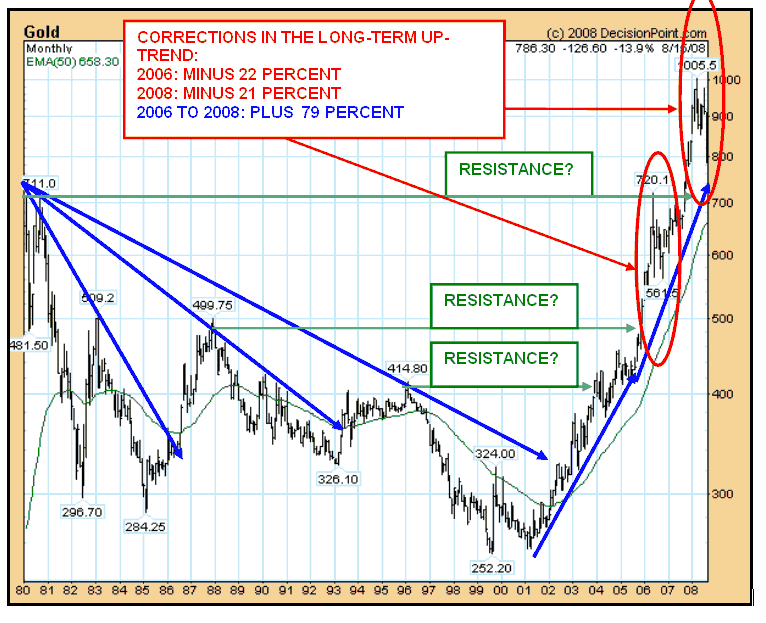
The 1999 bottom was tested again at the beginning of 2001. At that time, when few believed that any money should be put into precious metals, the present bull market started; a bull market we deem has still a long way to go in spite of the present correction.
In 2006, the gold price reached a fresh recovery high of $ 720.1 after a steep rise of roughly 80%. The correction that followed took it down to $ 560 or 22% before the gold price started to climb again. As per closing price of Friday August 15, gold has fallen 21% from its high reached in January 2008.
This correction resembles the one we had gone through in 2006. The long-term trend is intact and we expect the gold price to reach a new high not later than 2009.
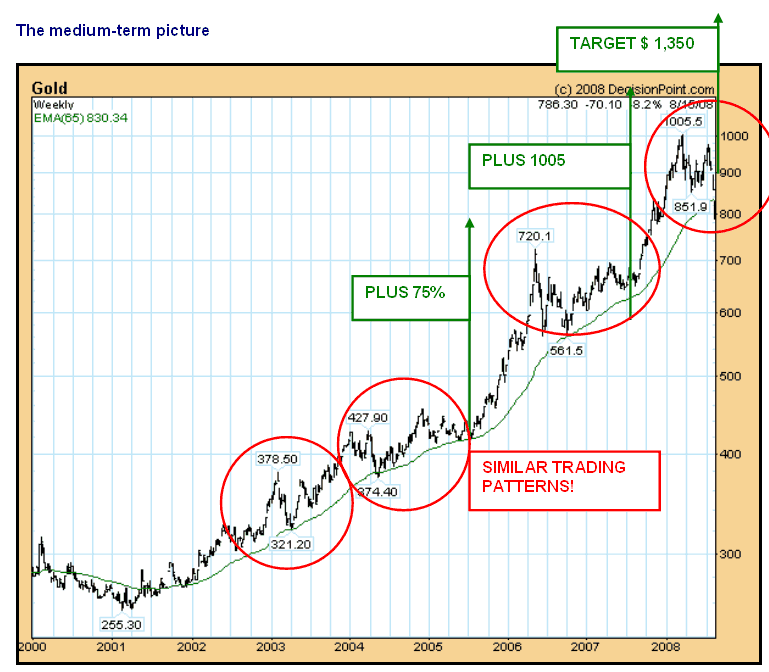
From the above presentation, it is easy to see that there have been many buying opportunities since this bull market started in 2001, along with some excellent prospects for selling. Each time the gold price fell back to or below the EMA 65 (green line) we would have been well advised if we had bought.
While prices have turned around each time they fell to the EMA 65, the situation is a bit different this time as the gold price has fallen below the average and stands at minus 5%. This situation could correct quickly and neutralize the negative impact.
At this junction, it can be helpful to see how unhedged gold stocks fared compared to gold :
The price of gold increased close to 250% since the start of the bull market in the year 2000. The HUI-Gold Bugs Index surged however 1,370% from its low to the high it reached so far with 519.7 points.
Higher percentage gains for the gold shares relative to the price of gold imply a higher volatility which means that corrections are also more severe when the price of gold corrects. This however should not concern us unduly as gold shares make up for any losses suffered very quickly once the gold price starts firming again.
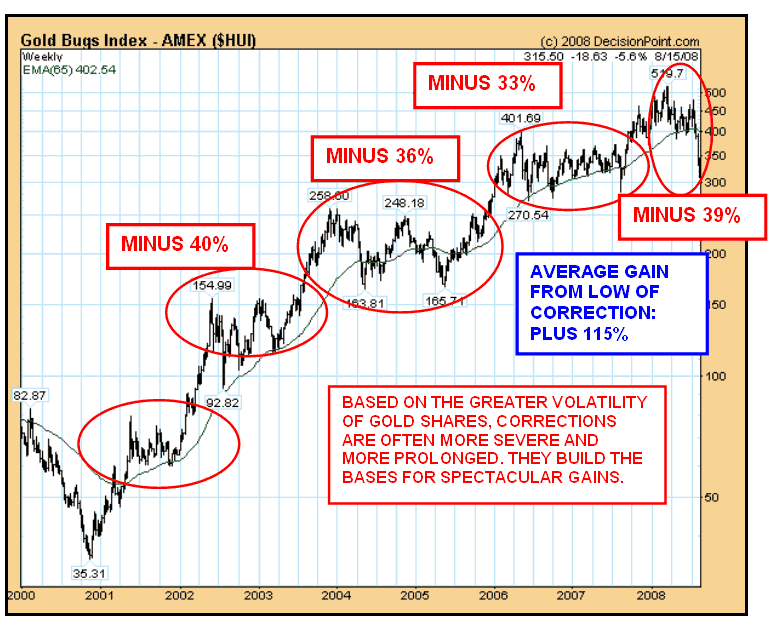
Should you own gold rather than gold shares?
Gold and gold shares do not move in a parallel fashion. At times, gold is leading, at times the gold shares.
We have shown above that gold shares over the long-term show a far better performance than the metal – in fact, since the start of the bull-market, gold shares outperformed the gold at ratio of 5 to 1.
In the short-term, the ratio between the price of gold and the HUI Index does not remain constant as the graph below demonstrates. A ratio of about 2 would be a long-term average but it can go up to reach 2.5 or 3 points or down to 1.5 points. Such extremes would be a signal of buying or selling opportunities.
Where are we now? We stand at 2.6 points. This indicates that the gold shares which are represented in the HUI Index have not kept pace with the gold price since the beginning for 2006 . Whether gold or gold shares will outperform in the future has to be seen but as we expect the gold price to move higher, w e would not be surprised when gold shares also would move up strongly, outperforming gold because they have fallen to an unrealistic low level based on the outlook for earnings, production or reserves.
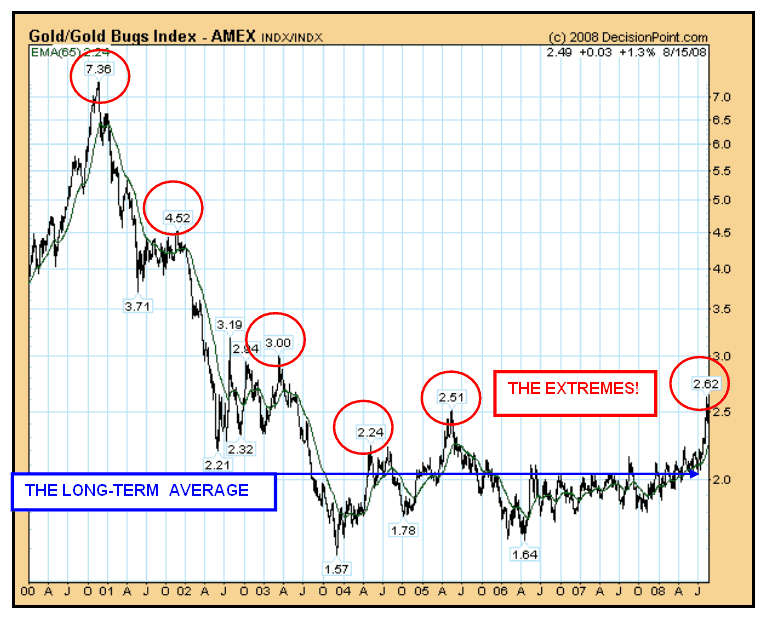
Are you frustrated owning junior gold stocks?
Probably yes. Major gold stocks fared much better during the first half of 2008 – until July.
Agnico-Eagle e.g traded at $ 82.80 at the beginning of July and has corrected since down to $ 51, a drop of almost 40%.The PE ratio based on 2009 estimated earnings has fallen from 50 to 30.
A PE ratio of 30 is still a high number but reflects the fact the big institutions have to buy the big caps because of the high trading volume, allowing them to buy or sell large amounts of stock.
Juniors like Alamos Gold held up better during the recent down-turn which can be seen in the chart below (BLUE CIRCLE)
We said in our last report that “This (the over-valuation of the majors) will change in our opinion. The large caps will tire. Money will seek stocks left behind and the juniors will experience a spectacular revival. It would be a sad mistake, on our mind, to switch now from juniors to mid and large cap stocks at this stage.”
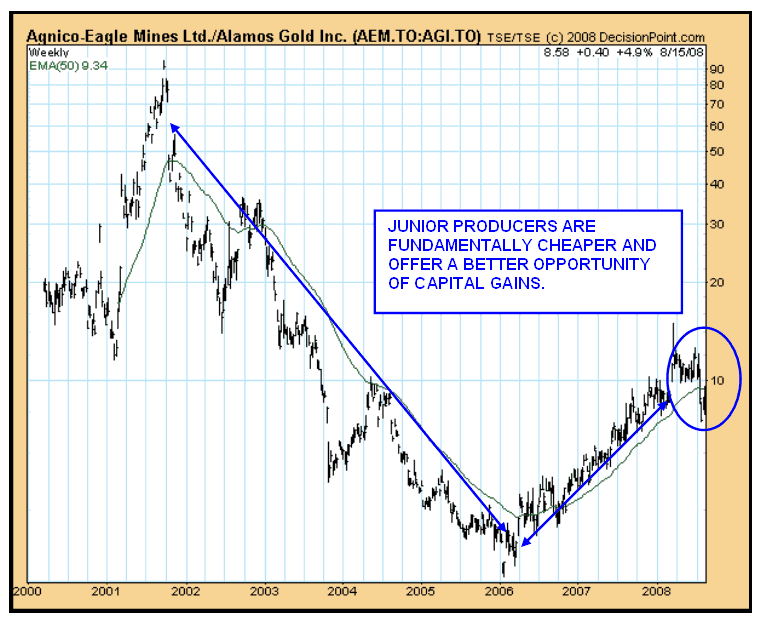
The recommendations were valid at the time of writing, viz. on 17th August 08
By Peter Zihlmann
www.pzim.com
invest@pzim
phone +41 44 268 51 10
mobile +41 79 379 51 57
Disclaimer: P. ZIHLMANN INVESTMENT MANAGEMENT AG does not accept any liability for any loss or damage whatsoever, that may directly or indirectly result from any advice, opinion, information, representation or omission, whether negligent or otherwise, contained in the trading recommendations or in any accompanying chart analyses, whether communicated by word, or message, typed or spoken by any of its employees.
Peter Zihlmann Archive |
© 2005-2022 http://www.MarketOracle.co.uk - The Market Oracle is a FREE Daily Financial Markets Analysis & Forecasting online publication.



